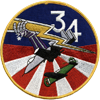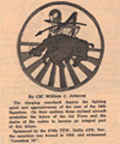Description: The patch is circular in design and edged in gold. The top half of the background is blue with a white “34” in the upper right. The lower half of the background has alternating red and white stripes that converge to the center of the patch. The patch has a gray A-10 Thunderbolt II in the center and a P-47 Thunderbolt immediately below the A-10. Both aircraft appear to be diving to the left. The patch has a bolt of lightning, which is gold with a white border that extends from the upper left to the lower right. The bolt is being by a gray and purple armored hand. The patch also has the Polaris star immediately below the hand holding the lightning bolt.
Significance: The four dominant colors, gold, blue, silver, and red, represent the different classes at the Air Force Academy. The A-10 represents the modern Air Force and the P-47 serves as a reminder of the rich heritage of the Air Force. Both aircraft are nicknamed “Thunderbolt,” just as the squadron is nicknamed “Thunderbolt.” The Polaris star reminds cadets to always look forward with high goals and ideals. The thunderbolt shows the strength and power of the United States Air Force, and the arm poised to throw the thunderbolt serves as a warning to all potential aggressors that America is ready and willing to use its military might to maintain its freedoms.
History: This is the squadron’s second patch, adopted in 1981, and designed by C2C Tracy M. Murakami, Class of 1983.
Nicknames: "Thunderbolt" "Loose Hawgs"
 1983 –
1983 –













